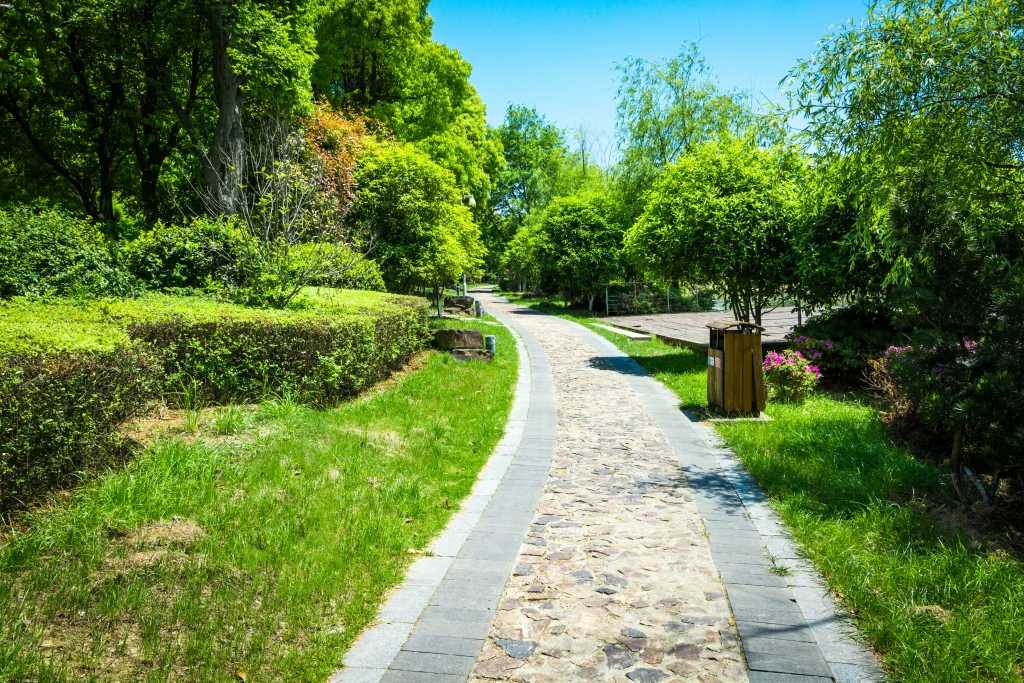When it comes to elevating the look and functionality of your garden, concrete landscape edging is a game-changer. This practical and visually appealing solution not only defines flower beds, walkways, and lawns with precision but also adds a polished touch to your yard.
Its durability and versatility make it a favorite for homeowners looking for long-lasting and low-maintenance ways to enhance their lawn care routine.
Concrete edging provides clean lines that prevent grass and soil from encroaching, making it easier to maintain a neat and organized outdoor space. If you’re seeking expert tree and lawn care solutions, Mile High Lifescape is the go-to provider for high-quality and affordable concrete edging services.
Ready to explore how this edging option can transform your garden? Let’s dive into the benefits and possibilities!
What Is Concrete Landscape Edging?
Concrete landscape edging, also known as concrete curbing, is a strong and flexible way to define different areas in your yard. It’s made from a mix of concrete, sand, and other materials, which are poured through a special machine to create smooth, even shapes.
Once the concrete hardens, it forms a strong barrier that can be used to outline flower beds, driveways, walkways, and other parts of your yard.
Concrete edging comes in different styles, like straight lines, curves, or even custom designs, so you can get creative with how you want your yard to look. It can also be colored or stamped to look like natural materials, like stone, brick, or wood, giving your yard a beautiful touch while still being as tough as concrete.
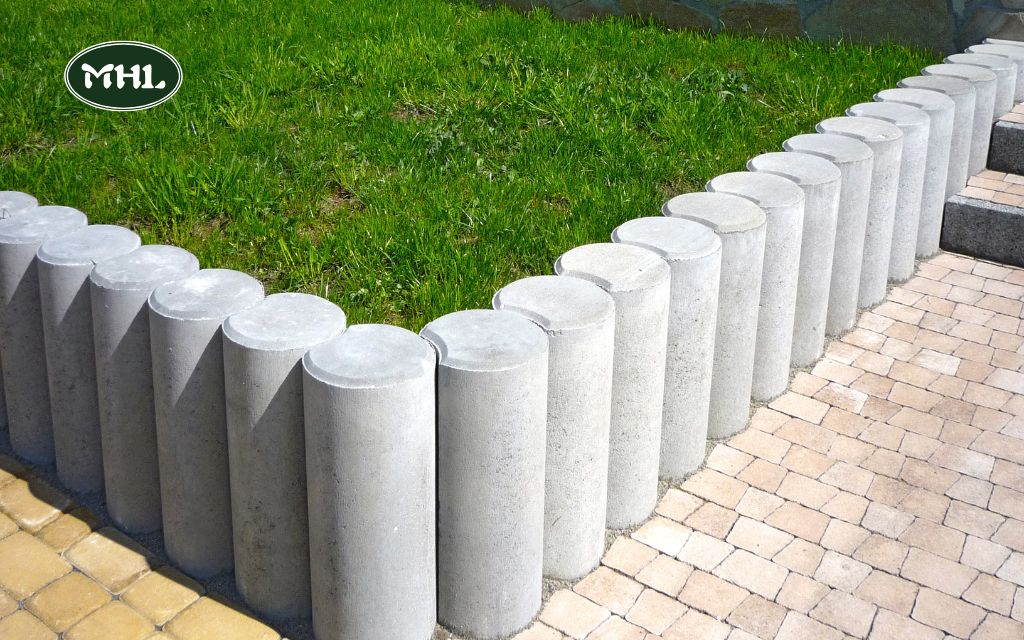
Types of Concrete Edging
Precast Concrete Edging for Uniform Shapes
Precast concrete edging involves manufacturing concrete sections in specific molds, resulting in consistent shapes and sizes. These ready-made pieces are ideal for creating uniform borders along pathways, flower beds, or driveways. The advantages of precast edging include:
- Ease of Installation: Since the pieces are performed, they can be quickly placed into position, reducing labor time.
- Variety of Designs: Available in various styles and finishes, precast edging can mimic natural stone, brick, or other materials, allowing for design flexibility.
- Durability: Manufactured under controlled conditions, precast concrete offers consistent quality and strength.
Custom Poured Edging for Unique Designs
Custom poured concrete edging is created on-site, allowing for personalized designs that conform to the specific contours of your landscape. This method offers several benefits:
- Design Flexibility: Custom pouring enables the creation of curves, angles, and unique shapes that complement the landscape’s layout.
- Seamless Appearance: Poured concrete provides a continuous border without joints, offering a sleek and modern look.
- Enhanced Strength: Being a monolithic structure, custom poured edging can be more resistant to shifting and settling over time.
Benefits of Concrete Landscape Edging
Customization
One of the great things about concrete landscape edging is that it comes in lots of different colors and styles. This means you can pick the perfect color and design to match your yard and keep your landscaping looking good all year, no matter what the weather is like.
Easy to Take Care Of
Concrete landscape edging is super easy to maintain. All you really need to do is sweep it with a broom or give it a quick wash with a light pressure washer to get rid of leaves or twigs. You don’t need to power wash it every season, and if you use a good sealer, it can last for years with hardly any work at all.
Cost-Effective
Compared to using stone or brick, concrete landscape edging is more affordable because it uses fewer materials. It’s also cheaper to install, and you won’t need to spend a lot of money on upkeep over time.
Good for the Environment
Concrete landscape edging is made from natural materials and doesn’t produce much waste, so it’s a more eco-friendly choice for your yard.
Resistant to Mold and Mildew
We apply a special sealer to our concrete edging, which helps prevent mold and mildew from growing. This means you won’t have to spend time scrubbing or treating your borders like you would with wood. Plus, it doesn’t hold onto water, especially during rainy seasons or winter.
Strong and Durable
Concrete landscape edging is built to last because it’s made from dense materials like sand. It can handle a lot of wear and tear while still looking great. Some styles can even be added over old brick or concrete, letting you update your yard without having to replace everything. Just make sure to check with the manufacturer first if you’re planning any changes.
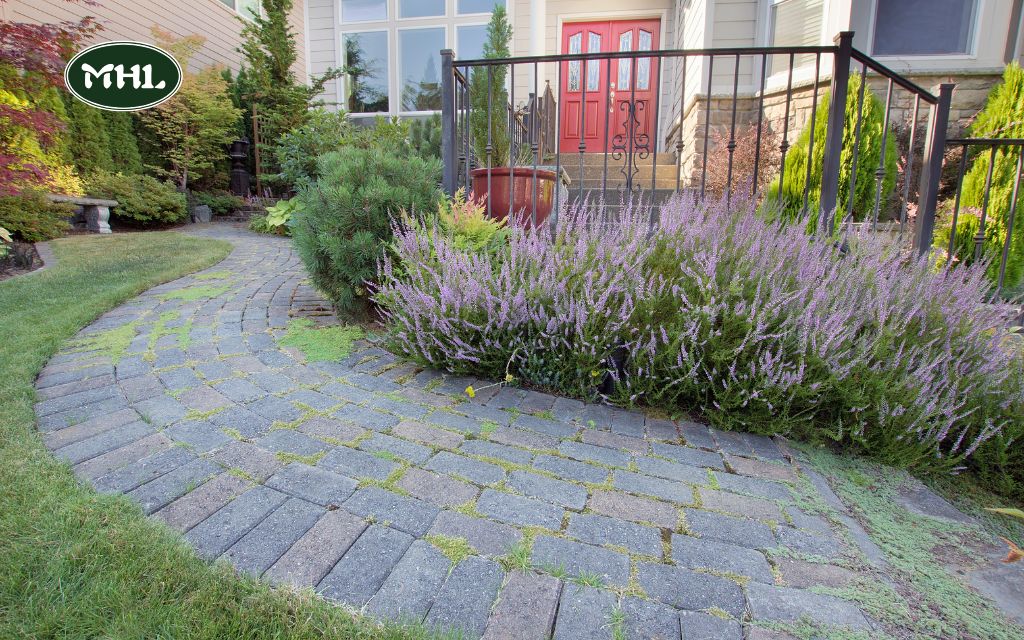
Popular Uses for Concrete Landscape Edging
Flower Beds and Gardens
Concrete edging serves as an effective barrier, preventing soil and mulch from spilling into adjacent areas. This containment not only maintains the tidiness of flower beds but also aids in moisture retention and weed suppression, promoting healthier plant growth.
Pathways and Walkways
Installing concrete edging along pathways and walkways provides a defined separation between walking surfaces and landscaped areas. This distinction enhances safety by guiding foot traffic and adds a polished look to the landscape design.
Lawn and Driveway Borders
Concrete edging acts as a physical barrier that prevents grass from encroaching onto driveways and other landscaped sections. This containment reduces maintenance efforts and contributes to a well-manicured appearance, boosting the property’s curb appeal.
Incorporating concrete landscape edging into these areas not only improves the organization and appearance of your outdoor space but also offers long-lasting durability and ease of maintenance.
How to Install Concrete Landscape Edging
Materials and Tools
- Concrete
- Stone (optional)
- Water
- Concrete mixer (or you can use a tub and shovel to mix)
- Shovel (a straight-edged one works best)
- Hoe
- Steel trowel
- Edging tool
- Chip brush (optional if you want a brushed finish)
- 2x4s for straight sections
- Hardboard or masonite for bending around corners
- Stakes to hold the forms in place (you can make them from scrap wood)
- Drill and screws (to join the forms together)
- Circular saw (for cutting the forms and control joints)
- Diamond masonry blade for the saw (make sure it fits your saw)
The cost of this project depends on what tools you need to buy, but the concrete and forming materials should cost less than $50. If you’re up for getting a little dirty, some DIY projects can be super affordable!
Step 1: Dig it Out
First, decide where you want the concrete landscape edging to go, and then start digging. A flat-edged shovel and hoe will make this easier. You don’t need to dig too deep—just a few inches below the ground level will do.
If you’re using 2x4s for the form, dig deep enough so the top of the form is at the height you want for your curb. A 3-4 inch layer of concrete will be strong enough. Also, make sure to dig the trench a bit wider on each side to fit your form.
Step 2: Form it Up
This step is really important because it shapes your concrete landscape edging. Use your 2x4s or masonite to create the form for your curb. The top of the form is where the top of your concrete will be, so make sure it’s at the height you want. Use stakes on the back side of the form to hold it in place while you work.
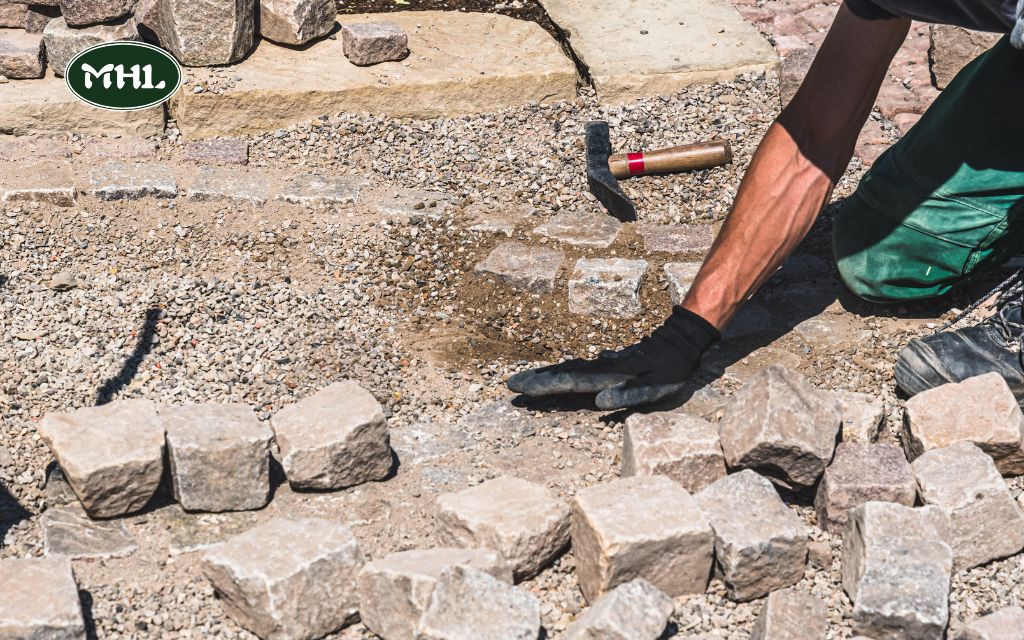
Step 3: Pour the Concrete
Before you pour the concrete, you might want to add a layer of stone at the bottom of the trench and press it down a little. This helps create a solid base and smooths out any uneven areas.
Now, it’s time to mix the concrete. Just follow the instructions on the bag, but I recommend making the mix a little wetter than usual. A wetter mix is easier to pour and flow into the form, and it doesn’t need to be super strong for the curbs.
Use a shovel to fill the form with the concrete. As you go, use your trowel to press the concrete into the corners and stir it a bit to get rid of air bubbles. It’s also a good idea to tap the outside of the form with your trowel or a hammer to help the concrete settle and fill in any gaps.
Once the form is full, use your trowel or a piece of wood to smooth the top of the concrete. After it starts to set just a little, use an edging tool to round the edges of the concrete.
Step 4: Cut the Control Joints
Control joints are important because they help stop cracks in your concrete by controlling where they happen. By cutting the concrete into smaller sections, you’re preventing stress points that could cause cracking.
If you leave your new concrete landscape edging as one long piece, it’s almost certain that it will crack, especially if it’s longer than 4-5 feet. The ground shifts with the weather, which will cause it to crack over time.
You can cut the control joints while the concrete is curing, but you need to wait until it’s just the right firmness. You can wait a couple of days until the concrete is solid enough, then use a masonry blade on my circular saw to make the cuts.
Design Ideas for Concrete Landscape Edging
Modern and Minimalist Edging
Achieve a sleek, modern appearance by incorporating straight-edged concrete borders in neutral shades like gray or white. This minimalist approach complements contemporary landscapes, providing clean lines that define garden beds, pathways, or lawns. The simplicity of this design enhances the overall elegance of your outdoor space.
Rustic and Textured Styles
For a more natural or rustic aesthetic, consider stamped or patterned concrete edging that replicates the texture and appearance of materials like stone or brick. This technique adds depth and character to your garden borders, seamlessly blending with the surrounding environment. It’s an excellent choice for those seeking a traditional look without the maintenance associated with natural stone.
Decorative Color Options
Introduce color to your landscape by using dyed or stained concrete landscape edging. This allows you to coordinate the borders with existing garden elements or to create a striking contrast that highlights specific areas. Colored concrete can be customized to match your design preferences, adding a personalized touch to your outdoor space.
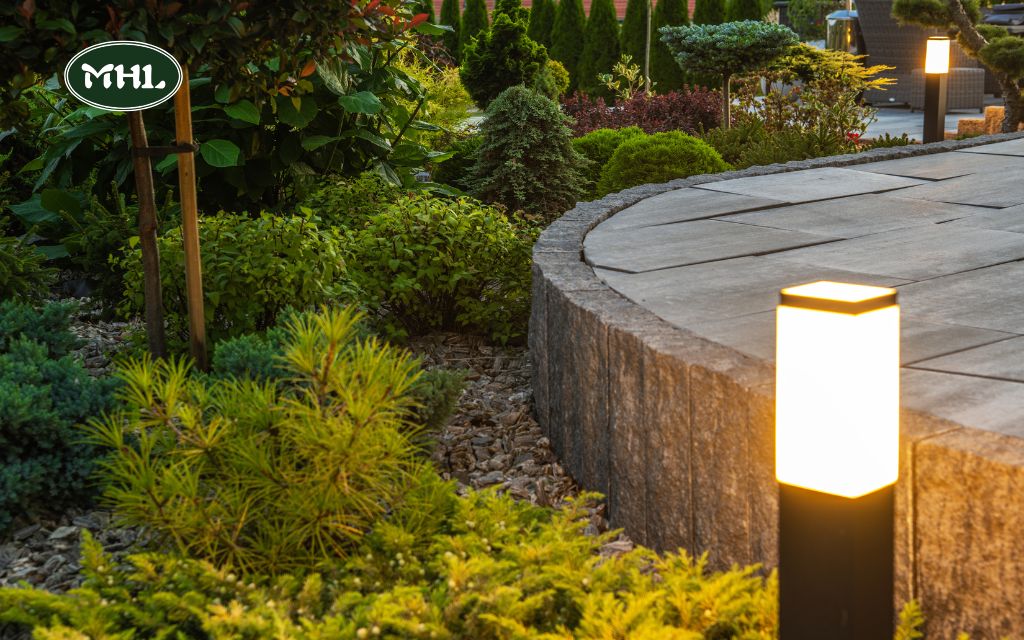
Mile High Lifescape: Best Landscape Edging Service in Denver
In Denver, Mile High Lifescape stands out as the premier provider of concrete landscape edging services. With over two decades of experience, our team is dedicated to transforming your outdoor space into a beautiful and healthy environment.
We offer personalized designs tailored to your specific needs and preferences, ensuring that your landscape not only looks stunning but also functions optimally. Our commitment to quality craftsmanship and customer satisfaction makes us the best choice for bringing your lawn dreams to life.
FAQs About Concrete Landscape Edging
Is concrete landscape curbing worth it?
Yes, concrete curbing is a worthwhile investment due to its durability, low maintenance, and ability to enhance the aesthetic appeal of your landscape. It provides a long-lasting solution that can withstand various weather conditions and adds value to your property.
What concrete should be used for landscape edging?
A standard concrete mix with a strength of at least 3,000 psi is typically used for landscape edging. This mix ensures durability and longevity. Additives can be included to enhance workability and finish.
How long does concrete edging last?
Concrete edging can last 15 to 20 years or more with proper installation and minimal maintenance, making it a long-term solution for landscape design.
Is concrete edging expensive?
Concrete edging is generally more expensive than materials like plastic or metal, with costs starting around $4 per foot. However, its durability and low maintenance can make it a cost-effective choice over time.
Conclusion
Concrete landscape edging is a smart, long-lasting way to enhance your yard’s beauty and organization. Its sleek design creates defined spaces while adding a professional touch to your garden. Durable and low-maintenance, it prevents grass encroachment and supports healthy plants.
Whether you prefer modern or rustic styles, Mile High Lifescape offers expert installation tailored to your vision. With over 20 years of experience, they ensure your landscape looks stunning and stays that way. Transform your outdoor space today with Denver’s trusted concrete edging professionals!
